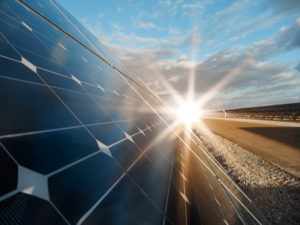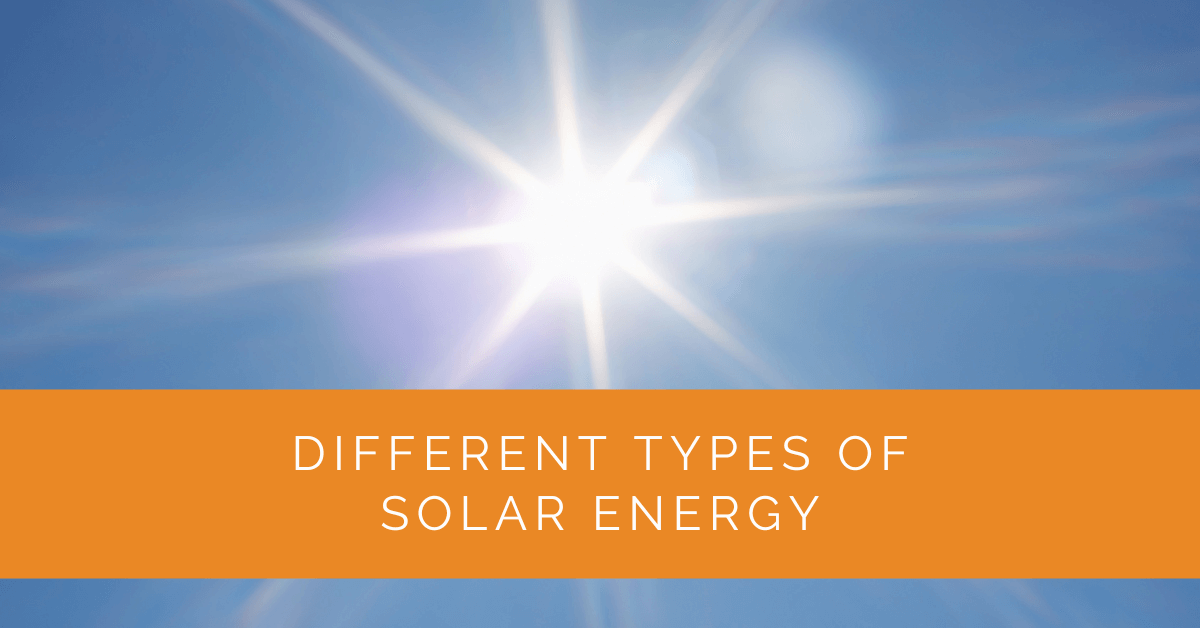Solar energy is a rapidly growing source of renewable power that offers numerous environmental and economic benefits. As the demand for cleaner energy solutions continues to rise, it’s important to understand the different types of solar energy available. In this article, we will delve into the various options, including photovoltaic (PV) solar energy, solar thermal energy (STE), concentrated solar power (CSP), passive solar energy, and building-integrated photovoltaics (BIPV). Let’s explore each type in detail and discover the incredible potential they hold for a sustainable future.
Contents
- 1 Key Takeaways
- 2 Understanding Solar Energy and its Benefits
- 3 Photovoltaic (PV) Solar Energy
- 4 Solar Thermal Energy (STE)
- 5 Concentrated Solar Power (CSP)
- 6 Passive Solar Energy
- 7 Building-integrated Photovoltaics (BIPV)
- 8 Expert Insights From Our Solar Panel Installers About Different Types of Solar Energy
- 9 Experience Solar Excellence with Us!
- 10 Conclusion: Embracing a Cleaner Energy Future with Solar Power
Key Takeaways
- Solar energy offers numerous benefits, including renewable and sustainable power generation, reduced environmental impact, cost savings, and application versatility.
- Photovoltaic (PV) solar energy is a widely used type of solar power that directly converts sunlight into electricity through solar cells, with options such as monocrystalline, polycrystalline, and thin-film panels.
- Other types of solar energy include solar thermal energy (STE) for heat generation, concentrated solar power (CSP) for electricity generation through concentration techniques, passive solar energy for energy-efficient building design, and building-integrated photovoltaics (BIPV) that seamlessly integrate solar panels into the architecture of buildings for both functionality and aesthetics.
Understanding Solar Energy and its Benefits
Before delving into the different types of solar energy, let’s first grasp the concept of solar energy itself and its numerous advantages. Solar energy is derived from the sun and can be converted into usable electricity or heat through various technologies. Here are some key benefits of solar energy:
- Renewable and Sustainable: Solar energy is an abundant and inexhaustible energy source, providing a sustainable solution to meet our power needs without depleting natural resources.
- Reduced Environmental Impact: Solar power generates electricity without emitting greenhouse gases, helping combat climate change and air pollution.
- Cost Savings: By harnessing solar energy, individuals and businesses can reduce their electricity bills and even generate excess power that can be sold back to the grid.
- Versatility: Solar energy can be utilized in various applications, including residential, commercial, and industrial sectors, as well as in remote locations where grid connection is challenging.
Photovoltaic (PV) Solar Energy
Introduction to Photovoltaic Solar Energy
Photovoltaic solar energy, commonly known as PV solar energy, is one of the most widely recognized and utilized forms of solar power. PV technology directly converts sunlight into electricity using solar cells made of semiconductor materials. These solar cells, typically composed of silicon, absorb photons from sunlight and initiate an electron flow, generating electricity.

How Photovoltaic Solar Panels Work
PV solar panels consist of interconnected solar cells encapsulated within a protective layer and framed to withstand environmental conditions. When sunlight hits the solar cells, the photons dislodge electrons from their atoms, creating a flow of electricity. This direct current (DC) is converted into alternating current (AC) through an inverter, making it suitable for powering appliances and feeding into the electrical grid.
Types of Photovoltaic Solar Panels
Monocrystalline Solar Panels
Monocrystalline solar panels are made from a single crystal structure, resulting in a uniform dark appearance. These panels offer high efficiency and are known for their sleek design. They are ideal when space is limited but require a higher initial investment.
Polycrystalline Solar Panels
Polycrystalline solar panels are manufactured from multiple silicon crystals, giving them a distinctive blue color. They are cost-effective and offer good efficiency levels. Polycrystalline panels are an excellent option for larger installations without constrained space.
Thin-Film Solar Panels
Thin-film solar panels are made by depositing thin layers of semiconductor material onto a substrate. They are lightweight, flexible, and have a lower cost of production. However, thin-film panels typically have lower efficiency than crystalline silicon panels, making them suitable for large-scale installations with ample space.
Factors Affecting Photovoltaic Solar Panel Efficiency
Several factors influence the efficiency of photovoltaic solar panels. Understanding these factors can help in optimizing the performance of solar systems. Some key considerations include:
- Solar Radiation: The intensity and duration of sunlight directly impact panel efficiency. Regions with higher solar radiation levels generally yield greater electricity generation.
- Temperature: High operating temperatures can reduce the efficiency of solar panels. Proper ventilation and mounting techniques can help mitigate the impact of temperature.
- Shading: Even partial shading on solar panels can significantly reduce their efficiency. Avoiding shading or implementing bypass diodes can minimize power losses.
Solar Thermal Energy (STE)
Overview of Solar Thermal Energy
Solar thermal energy harnesses the heat from the sun to generate usable thermal energy. Unlike photovoltaic systems that directly convert sunlight into electricity, solar thermal systems focus on capturing and utilizing the sun’s heat energy for various purposes.
Utilizing Solar Thermal Energy
Solar thermal energy systems consist of collectors that absorb solar radiation and transfer the captured heat to a fluid medium. This heated fluid can be used for multiple applications, such as water heating, space heating, and even powering industrial processes.
Applications of Solar Thermal Energy Systems
Solar thermal systems find applications in both residential and commercial settings. They can provide hot water for domestic use, supplement space heating in colder climates, and even support large-scale industrial processes that require substantial heat.
Concentrated Solar Power (CSP)
Introduction to Concentrated Solar Power
Concentrated Solar Power (CSP) systems employ mirrors or lenses to concentrate sunlight onto a receiver, which converts the focused sunlight into heat. This heat is used to drive turbines or engines that generate electricity.
How Concentrated Solar Power Works
CSP systems use concentrating technologies, such as parabolic troughs, power towers, and dish Stirling systems, to focus sunlight onto a central receiver. The concentrated heat is then used to produce steam or other fluids that drive turbines, generating electricity.
Major Types of Concentrated Solar Power Systems
Parabolic Trough Systems
Parabolic trough systems use curved mirrors in the shape of a trough to concentrate sunlight onto a receiver tube. This tube contains a fluid that heats up, and the heat is used to generate steam, driving a turbine to produce electricity.
Power Tower Systems
Power tower systems utilize an array of mirrors called heliostats to reflect sunlight onto a central tower receiver. The concentrated heat in the receiver is then used to produce steam and generate electricity through a turbine.

Passive Solar Energy
Understanding Passive Solar Energy
Passive solar energy uses building design principles and materials to harness solar power without using mechanical or electrical devices. It aims to maximize energy efficiency and thermal comfort by utilizing natural elements.
Passive Solar Technology and Design Principles
Passive solar design principles involve orienting buildings to optimize solar exposure, incorporating proper insulation, utilizing thermal mass, and implementing shading techniques to regulate heat gain and loss.
Benefits and Applications of Passive Solar Energy
Passive solar energy offers several benefits regarding energy efficiency, cost savings, and comfort. Here are some key advantages and applications:
- Energy Efficiency: By harnessing the sun’s energy passively, buildings can significantly reduce their reliance on mechanical heating and cooling systems, lowering energy consumption and utility bills.
- Comfortable Indoor Environment: Passive solar design principles aim to optimize natural light, thermal balance, and ventilation, creating a more comfortable and healthy indoor environment.
- Residential Applications: Passive solar techniques can be incorporated into new home construction or retrofitting existing buildings to enhance energy efficiency, reduce energy costs, and improve overall comfort.
- Commercial Applications: Passive solar strategies are also relevant in commercial buildings, where efficient daylighting, natural ventilation, and solar shading can create a pleasant and productive work environment.
Building-integrated Photovoltaics (BIPV)
Introduction to Building-integrated Photovoltaics
Building-integrated photovoltaics (BIPV) is a growing trend that combines solar energy generation with building materials, seamlessly integrating solar panels into the architecture of a structure. This approach offers both aesthetic and functional advantages.
Incorporating Photovoltaic Systems into Building Structures
BIPV systems encompass various design elements, such as solar windows, roof tiles, facades, and shading devices. These integrated solar panels generate electricity and serve as an architectural feature, promoting sustainable design and reducing reliance on conventional power sources.
Advantages and Challenges of BIPV
Building-integrated photovoltaics presents several advantages, including:
- Improved Aesthetics: BIPV seamlessly blends solar power generation with the building’s design, enhancing its visual appeal and architectural integration.
- Space Optimization: BIPV allows efficient use of available space by integrating solar panels into building elements that would otherwise remain unused.
- Energy Generation Potential: By utilizing multiple surfaces of a building, BIPV systems can potentially generate a higher amount of solar energy compared to traditional rooftop installations.
However, BIPV also faces challenges, including higher installation costs, specialized expertise required for integration, and careful design considerations to optimize energy generation without compromising architectural integrity.
Expert Insights From Our Solar Panel Installers About Different Types of Solar Energy
As an experienced solar installer, I always emphasize the importance of choosing the right type of solar panel. For instance, monocrystalline panels are perfect for homeowners with limited roof space because of their high efficiency and sleek design.
Senior Solar Installer
In large-scale industrial projects, we often recommend concentrated solar power (CSP) systems. These systems are highly effective for generating significant amounts of electricity, especially in areas with high direct sunlight.
Lead Solar Engineer
Building-integrated photovoltaics (BIPV) are a game-changer in modern architecture. They not only provide clean energy but also blend seamlessly with the building’s aesthetics, enhancing both functionality and design.
Architectural Solar Specialist
Experience Solar Excellence with Us!
Trust in Solar Panels Network USA, where our seasoned experts deliver top-quality solar solutions for homes and businesses nationwide. With a legacy of countless successful installations and a commitment to sustainable energy, we’re your reliable partner in the solar journey. Ready for a brighter, eco-friendly future? Call us now at (855) 427-0058 and harness the power of the sun!
Conclusion: Embracing a Cleaner Energy Future with Solar Power
Understanding the different types of solar energy is crucial as the world seeks to transition towards a cleaner and more sustainable energy future. Whether through photovoltaic solar panels, solar thermal systems, concentrated solar power, passive solar techniques, or building-integrated photovoltaics, solar power offers diverse options for harnessing the sun’s abundant energy.
By embracing solar energy, we can reduce our reliance on fossil fuels, lower greenhouse gas emissions, and pave the way for a cleaner and greener planet. From residential rooftops to large-scale solar farms, the sun’s power provides endless possibilities to create a more sustainable and energy-efficient world.
So, let’s harness the power of solar energy, leverage its numerous benefits, and contribute to a brighter and cleaner future for generations to come.
Remember, each type of solar energy has unique advantages and considerations, so it’s essential to evaluate your specific needs and consult with professionals to determine the most suitable solution for your energy requirements. Embrace solar power and join the global movement towards a cleaner and more sustainable future.

